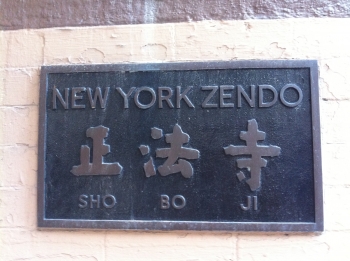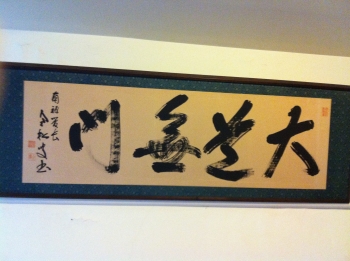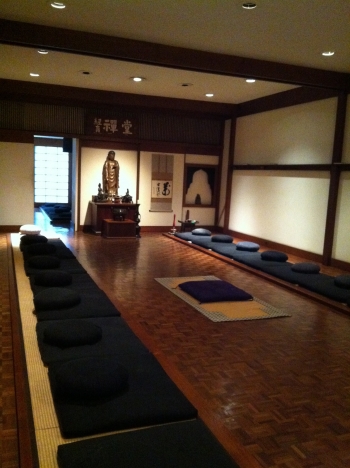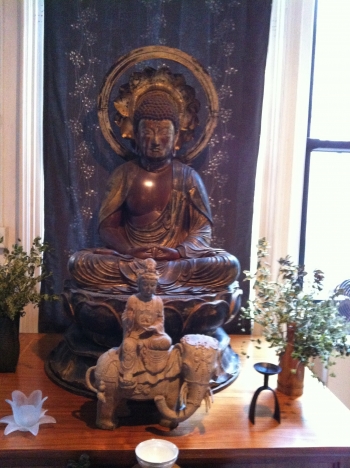Sangeeta Bansal Ph.D, a researcher and writer, is also the founder of a non-profit called Mindside, which aims to make the benefits of mindfulness meditation available to all. Mindside offers an eight-week curriculum that teaches mindfulness practices which have shown to bring about transformative change, from stress reduction, pain management, freedom from addiction and more. The program is offered to all age groups and all religious backgrounds. She can be reached at mindside08@gmail.com.
The tall, muscular and grim faced monk slowly picked up the kyosaku, a three feet long stick with a paddle shaped end, and held it vertically in front of his face. Clad in elaborate silk robes, he looked less like a monk and more of a samurai warrior ready for battle.
Slowly he made his way past the long row of men and women, sitting in variations of the lotus pose, on their zafus and zabutans. Not sure what to expect, I cautiously watched from downcast, narrowed eyes, trying not to appear too curious.
But as the first person in the row bent his head and bowed down, I had the distinct impression he was offering his head to a guillotine. The cracking sound of the kyosaku as it thrashed his shoulders was no less menacing. I saw the man wince as the kyosaku struck his body four times, twice on each shoulder, supposedly along acupressure meridians. Once the clouting had been administered, the recipient raised his hands in gassho to show gratitude and the monk acknowledged this with a deep bow – both displaying a spirit of mutual respect and understanding. I shuddered quietly as I let the monk (who was looking at me from the corner of his eye) walk slowly past me, afraid that any movement on my part might be misconstrued as acquiescence to the clouting.
This was not a ceremony being performed in medieval Japan by strict monks and their recalcitrant students. This was a Buddhist Zen meditation center on the Upper East Side in Manhattan, following the Rinzai sect within Japanese Zen Buddhism. Almost all the practitioners, as well as the monk who was leading the session, were American men and women who had shown up on a weeknight for two hours of zazen or sitting meditation. These free spirited, individualistic, opinionated and proud Americans would normally regard any kind of beating as a human indignity. Outside the zendo they might be seriously offended if someone cut in line in front of them or cut them mid-sentence. By contrast, the Japanese culture was known for its gentleness, its patience, and appreciation of beauty. In particular, were the Zen monks not the exemplars of gentle, peaceful and mindful ways of living? I could never imagine the gentle persona of Thich Nhat Hanh, whose workshop on mindfulness I had attended just a few months ago in Hong Kong, conducting such punishing acts on his monks in training. So what was going on here?
Ethnomethodology is a term used by sociologists to describe how people do things (or expect things) based on certain background assumptions. For example, one does not expect the doctor to give a haircut during a routine office visit, or a shopper to bargain with a supermarket clerk. We have certain expectations based on socialization and our worldly experience. Somehow, the violent use of a kyosaku in a meditation monastery did not fit that bill. It warranted an investigation!
I was spending the summer in New York City this year and had decided to do a world religions pilgrimage to see what the city offered its multi-ethnic citizens. In the last few years, I had been deeply moved by the teachings of the Buddha and my personal practice of meditation had now matured to a point that I looked forward to it every morning. I wanted to see what Buddhism offered to a New Yorker, typically embroiled in the fast paced and materialistic life that the great city offers. I had enrolled at the Zendo on the Upper East Side of Manhattan for their free two-hour Thursday night Zen meditation sessions, and this is where the kyosaku incident occurred. I requested a private interview with the attending monk and he readily obliged, much to my delight.
Ten Rai was a young monk, who claimed that his life was a mess before he showed up at the doors of the Daibosatsu monastery in the beautiful Catskills mountains of Upstate New York. The harsh discipline of the daily life at the monastery was what he needed at that point to anchor him. Upon my request, he also explained to me the significance behind the kyosaku. “It brings the wandering mind back during long periods of meditation. Although vehemently denied by some interpretations of the role ofkyosaku, it also serves to reprimand the monks for their lack of patience during meditation. When the posture slips and the shoulders slump, thekyosaku makes the monk sit up once again and gather his dissipated thoughts”. In the Rinzai discipline it is requested by a gesture as described above, whereas in the Soto sect a kyosaku is used without warning from behind as one sits facing the wall.


















